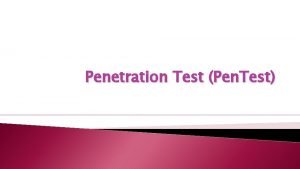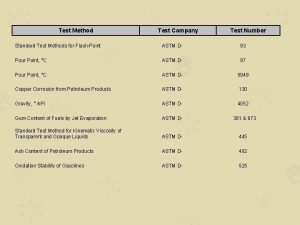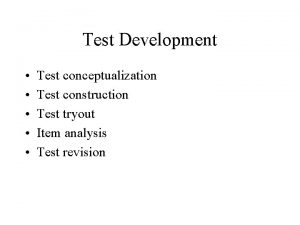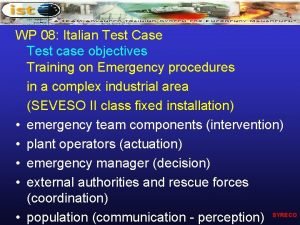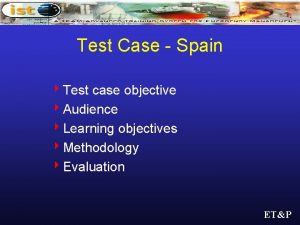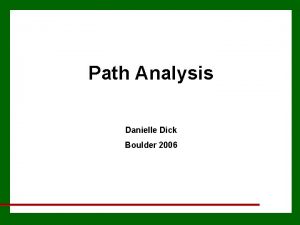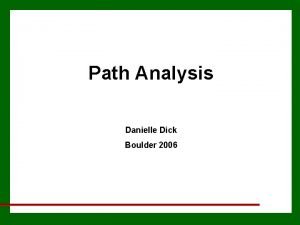Path Analysis Why path analysis for test case


















- Slides: 18

Path Analysis • Why path analysis for test case design? – Provides a systematic methodology. • Reproducible • Traceable • Countable • What is path analysis? – Analyzes the number of paths that exist in the system – Facilitates the decision process of how many paths to include in the test

Linearly Independent Path • A path through the system is Linearly Independent** from other paths only if it includes some segment that is not covered in the other path. - The statements are represented by the rectangular and diamond blocks. - The segments between the blocks are labeled with numbered circles. S 1 1 2 C 1 4 S 2 3 S 3 Path 1 : S 1 – C 1 – S 3 Path 2 : S 1 – C 1 – S 2 – S 3 OR Path 1: segments (1, 4) Path 2: segments (1, 2, 3) Path 1 and Path 2 are linearly independent because each includes some segment that is not included in the other. ** This definition will require more explanation later.

Another Example of Linearly Independent Paths S 1 1 C 1 2 S 2 8 9 Path 1: Path 2: Path 3: Path 4: 10 Note that these are all linearly independent 5 C 2 3 S 3 6 C 3 7 S 5 4 S 4 segments (1, 2, 8) segments (1, 5, 3, 9) segments (1, 5, 6, 4, 10) segments (1, 5, 6, 7)

Statement Coverage Method • Count all the linearly independent paths • Pick the minimum number of linearly independent paths that will include all the statements (S’s and C’s in the diagram) S 1 Path 1 : S 1 – C 1 – S 3 Path 2 : S 1 – C 1 – S 2 – S 3 1 2 C 1 4 S 2 3 S 3 Path 1 and Path 2 are needed to cover all the statements: (S 1, C 1, S 2, S 3) ?

Another Example of Statement Coverage S 1 1 C 1 2 8 S 2 The 4 Linearly Independent Paths Covers: 5 C 2 3 S 3 9 6 C 3 4 S 4 Path 1: Path 2: Path 3: Path 4: includes S 1 -C 1 -S 2 -S 5 includes S 1 -C 2 -S 3 -S 5 includes S 1 -C 2 -C 3 -S 4 -S 5 includes S 1 -C 2 -C 3 -S 5 10 7 S 5 For 100% Statement Coverage, all we need are 3 paths : Path 1, Path 2, and Path 3 to cover all the statements (S 1, C 1, S 2, C 2, S 3, C 3, S 4, S 5) - - - no need for Path 4 - -

Branch Coverage Method • Identify all the decisions • Count all the branches from the each of the decisions • Pick the minimum number of paths that will cover all the branches from the decisions.

Branch Coverage Method S 1 Decision C 1 : 1 Branch 1 C 1 Branch 2 B 1 : Path 1 : C 1 – S 3 B 2 : Path 2 : C 1 – S 2 – S 3 2 4 S 2 3 S 3 Path 1 and Path 2 are needed to cover both branches from C 1?

Another Example of Branch Coverage The 3 Decisions: S 1 C 1: 1 C 1 2 S 2 C 2: 5 C 2 3 S 3 9 7 S 5 4 S 4 - B 3 : C 2 – S 3 - B 4 : C 2 – C 3: - B 5 : C 3 – S 4 - B 6 ; C 3 – S 5 6 C 3 - B 1 : C 1 - S 2 - B 2 : C 1 - C 2 8 10 The 4 Linearly Independent Paths Covers: Path 1: Path 2: Path 3: Path 4: includes S 1 -C 1 -S 2 -S 5 includes S 1 -C 2 -S 3 -S 5 includes S 1 -C 2 -C 3 -S 4 -S 5 includes S 1 -C 2 -C 3 -S 5 We need: Path 1 to cover B 1, Path 2 to cover B 2 and B 3, Path 3 to cover B 4 and B 5, Path 4 to cover B 6

Mc. Cabe’s Cyclomatic Number • Is there a way to know how many linearly independent paths exist? – Mc. Cabe’s Cyclomatic number used to study program complexity may be applied. There are 3 ways to get the Cyclomatic Complexity number from a flow diagram. • # of binary decisions + 1 • # of edges - # of nodes + 2 • # of closed regions + 1 - Reference: T. J. Mc. Cabe, “A complexity Measure, ” IEEE Transactions on Software Engineering, Dec. 1976

Mc. Cabe’s Cyclomatic Complexity Number Earlier Example We know there are 2 linearly independent paths from before: Path 1 : C 1 – S 3 Path 2 : C 1 – S 2 – S 3 S 1 1 C 1 4 Mc. Cabe’s Cyclomatic Number: 2 Closed region S 2 3 S 3 a) # of binary decisions +1 = 1 +1 = 2 b) # of edges - # of nodes +2 = 4 -4+2 = 2 c) # of closed regions + 1 = 1 + 1 = 2

Mc. Cabe’s Cyclomatic Complexity Number Another Example Mc. Cabe’s Cyclomatic Number: a) # of binary decisions +1 = 2 +1 = 3 S 1 b) # of edges - # of nodes +2 = 7 -6+2 = 3 1 4 C 1 2 5 C 2 7 c) # of closed regions + 1 = 2 + 1 = 3 S 2 Closed Region S 4 6 3 S 3 There are 3 Linearly Independent Paths

An example of 2 n total path Since for each binary decision, there are 2 paths and there are 3 in sequence, there are 23 = 8 total “logical” paths S 1 1 2 C 1 3 S 2 path 5 : S 1 -C 2 -C 3 -S 4 path 6 : S 1 -C 2 -C 3 -S 5 path 7 : S 1 -C 2 -S 3 -C 3 -S 4 path 8 : S 1 -C 2 -S 3 -C 3 -S 5 4 C 2 5 S 3 6 How many Linearly Independent paths are there? Using Cyclomatic number = 3 decisions +1 = 4 7 C 3 8 S 5 path 1 : S 1 -C 1 -S 2 -C 3 -S 4 path 2 : S 1 -C 1 -S 2 -C 3 -S 5 path 3 : S 1 -C 1 -S 2 -C 2 -S 3 -C 3 -S 4 path 4 : S 1 -C 1 -S 2 -C 2 -S 3 -C 3 -S 5 One set would be: 9 S 4 path 1 : includes segments (1, 2, 4, 6, 9) path 2 : includes segments (1, 2, 4, 6, 8) path 3 : includes segments (1, 2, 4, 5, 7, 9) path 5 : includes segments (1, 3, 6, 9) Note 1: with just 2 paths ( Path 1 and Path 8) all the statements are covered. Note 2: with just 2 paths ( Path 1 and Path 8) all the branches are covered.

Example with a Loop Total number of paths may be “ infinite” (very large) because of the loop S 1 1 C 1 Linearly Independent Paths = 1 decision +1 = 2 4 S 3 path 1 : S 1 -C 1 -S 3 (segments 1, 4) path 2 : S 1 -C 1 -S 2 -C 1 -S 3 (segments 1, 2, 3, 4) 2 S 2 One path will cover all statements: (S 1, C 1, S 2, S 3) path 2 : S 1 -C 1 -S 2 -C 1 -S 3 3 One path will cover all branches: path 2 : S 1 -C 1 -S 2 -C 1 -S 3 branch 1 (C 1 -S 2) and branch 2 (C 1 -S 3)

More on Linearly Independent Paths • In discussing dimensionality, we talks about orthogonal vectors. – Two dimensional space has two orthogonal vector from which all the other vectors in two dimension can be obtained via “linear combination” of these vectors: • [1, 0] • [0, 1] [2, 4] [1, 0] [0, 1] e. g. [2, 4] = 2[1, 0] + 4[0, 1]

More on Linearly Independent Paths • A set of paths is considered to be a Linearly Independent Set if every path may be constructed as a “linear combination” of paths from the linearly independent set. For example: We already know: a) there a total of 22=4 logical paths. b) 2 paths that will cover all statements and all branches. c) 2 branches +1 = 3 linearly independent paths. C 1 2 1 S 1 1 3 C 2 5 4 S 1 6 path 1 1 path 2 1 2 3 4 5 6 1 1 1 path 3 1 1 path 4 1 1 1 We picked path 1, path 2 and path 3 as The Linearly Independent Set path 4 = path 3 + path 1 – path 2 = (0, 1, 1, 1, 0, 0)+(1, 0, 0, 0, 1, 1)- (1, 0, 0, 1, 0, 0) = (1, 1, 1, 1) - (1, 0, 0, 1, 0, 0) = (0, 1, 1, 0, 1, 1)

More on Linearly Independent Paths We already know: a) there a total of 22=4 logical paths. b) 2 paths that will cover all statements and all branches. c) 2 branches +1 = 3 linearly independent paths. C 1 2 1 S 1 1 3 C 2 5 4 S 1 6 path 1 1 path 2 1 2 3 4 5 6 1 1 1 path 3 1 1 path 4 1 1 1 Although path 1 and path 3 are linearly independent, they do NOT form a Linearly Independent Set because no linear combination of path 1 and path 3 can get , say, path 4.

More on Linearly Independent Paths • Because the Linearly Independent Set of paths display the same characteristics as the mathematical concept of basis in n-dimensional vector space, the testing using the Linearly Independent Set of paths is sometimes called the “basis” testing.

Paths Analysis • • Interested in Total number of “logical” paths Interested in Linearly Independent paths Interest in Branch coverage Interested in Statement coverage Which one is the largest set, next largest set, - - - , etc. ?
 Hey bye bye
Hey bye bye Best case worst case average case
Best case worst case average case Dont ask why why why
Dont ask why why why Qimata
Qimata Why-why analysis
Why-why analysis Contoh analisis akar masalah
Contoh analisis akar masalah Fspos vägledning för kontinuitetshantering
Fspos vägledning för kontinuitetshantering Typiska novell drag
Typiska novell drag Nationell inriktning för artificiell intelligens
Nationell inriktning för artificiell intelligens Returpilarna
Returpilarna Varför kallas perioden 1918-1939 för mellankrigstiden?
Varför kallas perioden 1918-1939 för mellankrigstiden? En lathund för arbete med kontinuitetshantering
En lathund för arbete med kontinuitetshantering Kassaregister ideell förening
Kassaregister ideell förening Personlig tidbok fylla i
Personlig tidbok fylla i A gastrica
A gastrica Förklara densitet för barn
Förklara densitet för barn Datorkunskap för nybörjare
Datorkunskap för nybörjare Stig kerman
Stig kerman Mall debattartikel
Mall debattartikel





















